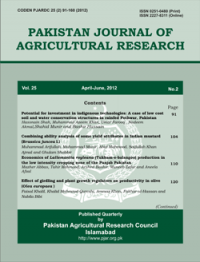PHYSICO-CHEMICAL CHANGES IN GRAINS OF SOME ADVANCE LINES/ VARIETIES OF RICE (ORYZA SATIVA L.) AFTER PARBOILING
Muhammad Akhter*, Muhammad Azhar Ali**, Zulqarnain Haider* and Shahzad Muzammil***
ABSTRACT
Some of the advance lines/varieties developed at Rice Research Institute, Kala Shah Kaku, including approved fragrant (Basmati) rice variety i.e., Basmati-2000, were used to assess interactive efficacy of parboiling on these varieties/lines and practical expediency of using standardized parboiling technique for improving nutritional, milling and cooking qualities of these lines/varieties. For this purpose, white milled and parboiled rice samples of ten lines/varieties were analyzed for nutritional quality parameters such as ash, dry matter, crude fat, crude protein, crude fiber, vitamin B6; milling quality parameters such as total milling recovery, head rice recovery, ratio of broken grains and cooking quality parameters such as curling, bursting and cooked grain length. The study showed significant variation in efficacy of parboiling to different varieties/lines. The results clearly showed average increase in mineral contents in terms of ash% increase, dry matter, longer cooked grain length and considerable rise in vitamin B6 contents, higher total milling recovery and head rice recovery in almost all the samples. While crude fiber, crude protein and crude fat decreased non-significantly. Furthermore, quality reducing factors such as number of broken grains, bursting and curling percentage of cooked rice were also reduced significantly in parboiled samples. It may, therefore, be suggested that parboiling offers a better alternative to conserve and increase nutritional, milling and cooking quality values of rice varieties/lines. Less percentage of broken, burst and curled grains may result in augmented net income.
To share on other social networks, click on any share button. What are these?






